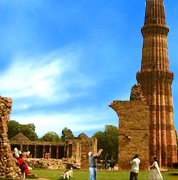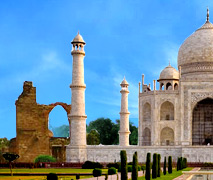Mahabalipuram India, Mahabalipuram Tourism, Mahabalipuram City, Mahabalipuram Travel, Travel to India.

World famous for its shore temples, Mahabalipuram or Mamallapuram, was the
second capital of the Pallava kings of Kanchipuram. 58 kilometres from
Madras, situated on the Bay of Bengal, this tiny seaside village is set
in a boulder-strewn landscape. Tourists are drawn to this place by its
miles of unspoiled beach and rock-cut art. The sculpture of this place
is particularly interesting, because it shows scenes of day-to- day
life, in contrast to the rest of the state of Tamil Nadu, where carvings
generally depict gods and goddesses.
Mahabalipuram art is divided into four categories: open air
bas-reliefs, structured temples, man-made caves and rathas ('chariots'
carved from single boulders, to resemble temples or chariots used in
temple processions). The famous Arjuna's Penance and the Krishna
Mandapa, adorn massive rocks near the centre of the village. The
beautiful Shore Temple towers over the waves, behind a protective
breakwater. Sixteen manmade caves in different stages of completion are
also seen scattered through the area. Mahabalipuram with its picturesque
location on a rocky outcrop between the beach and a lagoon is a happy
combination of history, good beaches, hassle-free tourism and fabulous
fish and lobster. Despite the many visitors, drawn by the former Pallava
dynasty town, the place is friendly, relaxed, and the villagers are
remarkably unperturbed by their crowds of visitors.
Shopping Attractions
Mahabalipuram has kept alive and, to a great extent, revived the
ancient art of stonemasons and sculptures including deities for temples
and other forms for restoration works. These images and statues are
available at several handicraft emporia scattered around the city. Some
marvelously carved images of Hindu gods in soapstone or on wood are
popular buys along with jewellery and decorative items made from
seashells.
Prime Attractions
Arjuna's Penance
Arjuna's Penance, a colossal and massive relief made on two huge
boulders, is the universe itself in stone. 27 metres long and 9 metres
high, it is perhaps the world's largest bas-relief. The cleft in the
rock depicts the descent of the Ganga, brought to earth by King
Bhagiratha to redeem the cursed souls of his ancestors. The two large
elephants are remarkable for their artistry, and so are the scenes from
the Panchatantra. There is a forest with tribal people and all forms of
animal life, just as they would appear in their habitat. Women are
clothed in an aura of ineffable grace, a rich inner beauty transfiguring
the plainest of them. The whole scene has a delicate edge of humor.
Juxtaposed against the ascetic is a cat doing rigorous penance too.
Caves
The Varaha Cave, a small rock-cut mandapam (hall), is a faceted and
finished gem with two incarnations of Vishnu-Varaha (boar) and Vamana
(dwarf). Particularly noteworthy here are four panels of the famous
Pallava doorkeepers. There is about them a mood of contemplative
reverie, a lyrical softness and subtle grace totally at variance with
the primordial machismo their role as guards of the gods imposes on
them. The Mahisasurmardini Cave (mid-seventh century) has fine
bas-reliefs on its panels of enduring beauty. The Dharmaraja Cave, built
in the early seventh century, contains three empty shrines. The
Somaskanda sculpture radiates peace, power, and wisdom while Lord Vishnu
is shown in omniscient repose in a masterpiece of dhwani (the art of
suggestion). On the opposite side is a huge theatrical panel showing,
Goddess Durga's fight with the demon Mahishasura, an episode culled from
the celebrated Sanskrit poem Devi Mahatmya. About 5 km north of
Mahabalipuram is another cave called Tiger Cave, a rock-cut shrine
possibly dating back to 7th century.
Rathas
A group of structures lying at the southern extreme of Mahabalipuram,
amidst casuarina trees, are the famous Rathas (chariots). The Pancha
Pandava Rathas, as they are called, are five in number. Out of these,
four are carved out of a single rock, while the fifth on the west is
scooped out from a small rock. The square Draupadi and Arjuna Rathas,
the linear Bhima Ratha, the taller Dharamraja Ratha and the apsidal
Nakula-Sahadeva Ratha, constitute the complex.
Krishna Mandapam
The Krishna Temple is one of the earliest rock-cut temples of
Mahabalipuram. The walls of the temples depict scenes of pastoral life,
one with the image of Krishna lifting the Govardhan Hill in his
fingertips to protect his people from Indra.
Shore Temple

The windswept and surf-beaten Shore Temple, the mute tireless sentinel of
the shore, is the ultimate expression of Mahabalipuram. A three-in-one
abode of God-a Vishnu temple positioned between two Shiva temples, is a
visual delight with its precincts abounding in architectural
masterpieces. On either side of it the sea spreads, illimitable and
infinite. The compound wall of this temple is lined with charming
sculptures of Nandi the bull while the figure of Vishnu is present in
the sanctum sanctorum.
Mahabalipuram Dance Festival:
Mahabalipuram Dance Festival is an occasion for the dance lovers to
enjoy the performances of the artists from all parts of the country. The
festival is celebrated in the month of January/February every year. The
Shore Temple forms the backdrop of this festival and the music from the
musical instruments mixes with the natural music of wind and the sea.
The Mahabalipuram Dance festival is an occasion when artists from all
over the country come together to perform.
How To Reach
 World famous for its shore temples, Mahabalipuram or Mamallapuram, was the
second capital of the Pallava kings of Kanchipuram. 58 kilometres from
Madras, situated on the Bay of Bengal, this tiny seaside village is set
in a boulder-strewn landscape. Tourists are drawn to this place by its
miles of unspoiled beach and rock-cut art. The sculpture of this place
is particularly interesting, because it shows scenes of day-to- day
life, in contrast to the rest of the state of Tamil Nadu, where carvings
generally depict gods and goddesses.
World famous for its shore temples, Mahabalipuram or Mamallapuram, was the
second capital of the Pallava kings of Kanchipuram. 58 kilometres from
Madras, situated on the Bay of Bengal, this tiny seaside village is set
in a boulder-strewn landscape. Tourists are drawn to this place by its
miles of unspoiled beach and rock-cut art. The sculpture of this place
is particularly interesting, because it shows scenes of day-to- day
life, in contrast to the rest of the state of Tamil Nadu, where carvings
generally depict gods and goddesses.







 The windswept and surf-beaten Shore Temple, the mute tireless sentinel of
the shore, is the ultimate expression of Mahabalipuram. A three-in-one
abode of God-a Vishnu temple positioned between two Shiva temples, is a
visual delight with its precincts abounding in architectural
masterpieces. On either side of it the sea spreads, illimitable and
infinite. The compound wall of this temple is lined with charming
sculptures of Nandi the bull while the figure of Vishnu is present in
the sanctum sanctorum.
The windswept and surf-beaten Shore Temple, the mute tireless sentinel of
the shore, is the ultimate expression of Mahabalipuram. A three-in-one
abode of God-a Vishnu temple positioned between two Shiva temples, is a
visual delight with its precincts abounding in architectural
masterpieces. On either side of it the sea spreads, illimitable and
infinite. The compound wall of this temple is lined with charming
sculptures of Nandi the bull while the figure of Vishnu is present in
the sanctum sanctorum.



